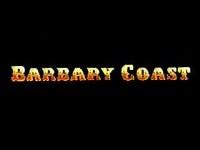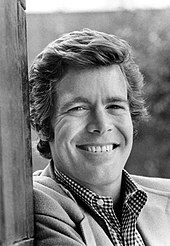| Barbary Coast | |
|---|---|
 | |
| Genre | Western/ Spy-fi |
| Created by | Douglas Heyes |
| Written by |
|
| Directed by |
|
| Starring | |
| Composer | John Andrew Tartaglia |
| Country of origin | United States |
| Original language | English |
| No. of seasons | 1 |
| No. of episodes | 13 |
| Production | |
| Executive producer | Cy Chermak |
| Producer |
|
| Cinematography | Robert B. Hauser |
| Editors |
|
| Running time | 45 mins. |
| Production companies |
|
| Original release | |
| Network | ABC |
| Release | May 4, 1975 – January 9, 1976 |
Barbary Coast is an American television series that aired on ABC. The pilot film first aired on May 4, 1975, and the series itself premiered September 8, 1975; the last episode aired January 9, 1976. [1]
Synopsis

With an 1870s setting, [2] Barbary Coast features the adventures of government agent Jeff Cable (played by William Shatner), and his pal, conman and gambler Cash ("Cash makes no enemies") Conover ( Doug McClure; played by Dennis Cole in the pilot) who is the owner of the Golden Gate Casino. The title was taken from the setting, "a square-mile section of San Francisco called the Barbary Coast, a wide-open, rip-roaring district whose inhabitants ranged from flashy ladies to sourdoughs." [3]
This was Shatner's first live-action series since Star Trek (also produced by Paramount Television). [4]
Cable and Conover battled against various criminals, and Cable frequently donned disguises in the course of his investigations. [3]
Cast
In addition to Shatner and McClure, regulars on the series included:
- Richard Kiel - Moose Moran, the bouncer [5]
- Dave Turner - Thumbs, the piano player [5]
- Bobbi Jordan - Flame, the croupier [5]
- Francine York - Brandy, a dance-hall girl [5]
- Brooke Mills - Rusty, a dance-hall girl [5]
Schedule and production
Barbary Coast was broadcast initially on Mondays from 8 to 9 p.m. Eastern Time. Beginning October 31, 1975, it moved to Fridays from 8 to 9 p.m. ET and stayed there for the rest of its run. Its competition included Rhoda, Phyllis, Big Eddie, M*A*S*H, and films on CBS. Competing shows on NBC were The Invisible Man, Sanford and Son and Chico and the Man. [6]
Because the show was broadcast during the Family Viewing Hour, on-screen violence was kept to a minimum. Reduction of shootings and visible deaths required revisions in scripts. At one point before it went on the air, ABC changed the title to Cash and Cable because "ABC decided the name conjured up a violent image," Shatner said. [7] After some testing, however, executives determined that people preferred Barbary Coast. [7]
Production was delayed for 10 days after Shatner's ankle was broken when a horse kicked him. After his return, rains collapsed tarpaulins that protected segments of the set, causing two crew members to nearly drown. Mosquitoes attacked the set "and a wide variety of illnesses appeared and spread from one worker to another." [8]
Douglas Heyes was the series's creator. Cy Chermak was the executive producer. [1] Directors included Bill Bixby, John Florea, Alex Grasshoff, and Don McDougall. [6]
ABC had plans for a similar show seventeen years earlier. The trade publication Billboard reported in its January 20, 1958, issue, "ABC-TV — Set Barney Girard to produce and direct Barbary Coast, Adventure story laid in early San Francisco." [9]
Critical response
Alex McNeil, in the book Total Television, described the program as a "limpid western". [1]
John J. O'Connor, in a review in The New York Times, commented after the first episode that Barbary Coast and another show that premiered the same night "seem reasonable candidates for the disaster bin." [2] He specified that production was "bad throughout" and referred to segments that featured dancing girls in Cash's casino with the comment, "But the entire Bolshoi Ballet would have difficulty salvaging Barbary Coast." [2]
Alvin H. Marill, in the book Television Westerns, said the series "may or may not be considered a true Western" and went on to describe it as "an adventure/spy series". [10]
Episodes
| No. | Title | Directed by | Written by | Original air date | |
|---|---|---|---|---|---|
| 0 | "The Barbary Coast" | Bill Bixby | Douglas Heyes | May 4, 1975 | |
| Two-hour TV-movie and backdoor pilot. | |||||
| 1 | "Funny Money" | Don Weis | Douglas Heyes | September 8, 1975 | |
| 2 | "Crazy Cats" | Don Weis | Harold Livingston | September 15, 1975 | |
| 3 | "Jesse Who?" | Bill Bixby | Howard Berk | September 22, 1975 | |
| 4 | "The Ballad of Redwing Jail" | John Florea |
S : Douglas Heyes; T : William D. Gordon & James Doherty | September 29, 1975 | |
| 5 | "Guns for a Queen" | Don McDougall |
S : Matthew Howard; T : William Putnam | October 6, 1975 | |
| 6 | "Irish Luck" | Alex Grasshoff | Harold Livingston | October 13, 1975 | |
| 7 | "Sauce for the Goose" | Don McDougall |
S : Michael Lynn & George Reed; T : Stephen Lord | October 20, 1975 | |
| 8 | "An Iron-Clad Plan" | Herb Wallerstein |
S : George Reed & Michael Lynn; T : L. Ford Neale & John Huff | October 31, 1975 | |
| 9 | "Arson and Old Lace" | Alex Grasshoff | Max Hodge | November 14, 1975 | |
| 10 | "Sharks Eat Sharks" | Bruce Bilson | James L. Henderson | November 21, 1975 | |
| 11 | "The Day Cable Was Hanged" | Alex Grasshoff |
S : Howard Rayfiel & Kellam de Forest; T : Stephen Ford | December 26, 1975 | |
| 12 | "Mary Had More Than a Little" | Herb Wallerstein | Winston Miller | January 2, 1976 | |
| 13 | "The Dawson Marker" | Alex Grasshoff | William D. Gordon & James Doherty | January 9, 1976 | |
Awards and nominations
The pilot episode, an ABC Sunday Night Movie, was nominated for an Emmy Award for Art Direction for Jack De Shields and set decorator Reg Allen. [11]
Cultural references

The Mad Magazine Star Trek musical satire "Keep on Trekkin'" (1976) depicts William Shatner as Captain James T. Kirk on the bridge of the U.S.S. Enterprise singing a version of " Send in the Clowns" [12] that includes the lyric "Look at me now/At my old post/Happy that I can forget Barbary Coast!".[ citation needed]
References
- ^ a b c McNeil, Alex (1996). Total Television: the Comprehensive Guide to Programming from 1948 to the Present (4th ed.). New York, New York: Penguin Books USA, Inc. p. 74. ISBN 0-14-02-4916-8.
- ^ a b c O'Connor, John J. (September 8, 1975). "TV: 'Barbary Coast' and 'Phyllis' Bow". The New York Times. p. 62. Retrieved March 25, 2023.
- ^ a b Brooks, Tim; Marsh, Earle F. (June 24, 2009). The Complete Directory to Prime Time Network and Cable TV Shows, 1946-Present. Random House Publishing Group. p. 102. ISBN 978-0-307-48320-1. Retrieved March 25, 2023.
- ^ Edelstein, Robert (2021-07-03). "William Shatner Reflects on 'Barbary Coast' & Jeff Cable's Many Disguises". TV Insider. Retrieved 2023-09-22.
- ^ a b c d e Terrace, Vincent (January 10, 2014). Encyclopedia of Television Shows, 1925 through 2010, 2d ed. McFarland. p. 74. ISBN 978-0-7864-8641-0. Retrieved March 25, 2023.
- ^ a b Hyatt, Wesley (October 6, 2015). Short-Lived Television Series, 1948-1978: Thirty Years of More Than 1,000 Flops. McFarland. pp. 240–241. ISBN 978-1-4766-0515-9. Retrieved March 25, 2023.
- ^ a b Bednarski, P. J. (July 25, 1975). "Killing played down in 'Barbary Coast'". The Journal Herald. Ohio, Dayton. p. 59. Retrieved March 25, 2023 – via Newspapers.com.
- ^ Biggers, Buck (December 27, 1975). "'Barbary Coast': Trouble from the start". The Courier-News. New Jersey, Bridgewater. Gannett News Service. p. D-11. Retrieved March 25, 2023 – via Newspapers.com.
- ^ "Agency, web interest in shows on upbeat". Billboard. January 20, 1958. p. 6. Retrieved March 25, 2023.
- ^ Marill, Alvin H. (June 1, 2011). Television Westerns: Six Decades of Sagebrush Sheriffs, Scalawags, and Sidewinders. Scarecrow Press. p. 88. ISBN 978-0-8108-8133-4. Retrieved March 25, 2023.
- ^ Emmy Nomination Certificate
- ^ Mark Clark (April 1, 2012). Star Trek FAQ: Everything Left to Know About the First Voyages of the Starship Enterprise. Applause Theatre & Cinema. pp. 44–45. ISBN 978-1557839633.
External links
- Barbary Coast TV movie at IMDb (television movie)
- Barbary Coast (series) at IMDb
- American television films
- Television series by CBS Studios
- American Broadcasting Company original programming
- 1975 American television series debuts
- 1976 American television series endings
- 1970s Western (genre) television series
- Espionage television series
- 1975 television films
- 1975 films
- American English-language television shows
- Barbary Coast, San Francisco
- Television series set in the 19th century
- Television shows set in San Francisco